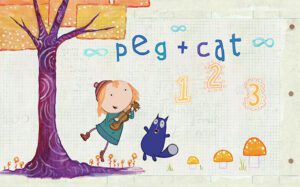From family rooms to policy papers, conversations about young children and media are changing. Along with the growing ubiquity of media and technology comes the awareness that keeping children away from screens might not be possible, or even desirable. So a key question is how to use digital media and technology with young children to support their learning and development. In this post, we describe how new research from Education Development Center(EDC) and SRI can inform and advance the dialogue on this important topic.
Researchers from EDC and SRI Education recently released findings from a joint study that illustrated how public media resources—specifically the PBS show, PEG+CAT—could support productive media experiences for children and their parents. The nearly 200 families who participated were randomly assigned either to a PBS KIDS group or a comparison group. Parents and children in the PBS KIDS group engaged with a set of PEG + CAT videos, online games, a tablet-based app, and print activities over a 12-week period while comparison group families continued with ‘business as usual’ media use.
Study findings highlighted positive outcomes for children and their parents. Children in the PBS KIDS group showed stronger improvement than the comparison group in key math skills, including ordinal numbers, spatial relationships, and identifying 3-D shapes. Parents in the PBS KIDS group reported more joint parent-child technology use and more conversation connecting media, mathematics, and daily life than parents in the comparison group. PBS KIDS parents also reported increased confidence in helping their children learn math, and agreed that technology was a valuable tool for doing so.
The study findings coincide with profound shifts in how people are thinking and talking about young children’s use of digital media. Acknowledging that ‘screen time’ is becoming simply ‘time,’ the American Academy of Pediatrics (AAP) is preparing to release new recommendations for children’s screen time later this year that will offer concrete guidance for how parents can maximize learning opportunities while minimizing risk. If that sounds like regular parenting—well, that’s the point. As Dr. Ari Brown, chair of AAP’s Media Leadership Work Group, notes, “Media aren’t necessarily so different from other environments in which children hang out.”

The new AAP guidelines align with the position of the National Association for the Education of Young Children (NAEYC) and the Fred Rogers Center—that “when used wisely, technology and media can support learning and relationships.” And the wise use of media often involves caring adults playing an important role in shaping children’s media experiences.
For example, a recent report from the early childhood organization Zero to Three highlights that learning can happen “when parents and other trusted adults make screen use an interactive, shared experience.” In a similar vein, experts at AAP’s Growing Up Digital symposium and the Joan Ganz Cooney Center underscored the importance of ‘co-viewing’, ‘co-participation’ and ‘joint media engagement’ to describe how children and adults can learn together with media.
A key question, then, is how to use digital media and technology with young children to support their learning and development—and in this context, findings from the study are especially pertinent. Joint parent-child media use was an emphasis of the research and positive shifts in parents’ confidence and behaviors may have resulted from exposure to study activities. Parents in the PBS KIDS group were asked to interact with their children around the videos and games. Perhaps more importantly, they were supported in doing so through a variety of resources—including parent tip videos, a printed guide, and weekly text messages—which provided practical suggestions for using the media to foster children’s mathematical exploration and extend it beyond the familiar basics.
Another salient characteristic of the study is its focus on equity. This research is part of the CPB-PBS Ready To Learn Initiative; funded by the U.S. Department of Education. This initiative aims to develop high-quality educational media for children aged 2-8, particularly in low-income communities. In 2010-2015, Ready To Learn research investigated how public media resources could support children’s mathematics learning in various settings. The Ready To Learn Home Study described above was an important part of this five-year cycle. By attending to several important features, including a rigorous, experimental design, a large sample of families, and an explicit focus on low-income communities, this study broke new empirical ground in the research on children’s media use at home.
In terms of what we can learn about media use in family settings, the study described above is just the beginning. The new round of Ready To Learn research currently getting underway will continue to focus on the home and examine how families can use media for science and literacy learning. So stay tuned—there’s more to come.
This material is based upon work supported by U.S. Department of Education under award number U295A100025. Any opinions, findings and conclusions or recommendations expressed in this material are those of the authors and do not necessarily reflect the views of the Education Development Center, the Corporation for Public Broadcasting, or the U.S. Department of Education.


